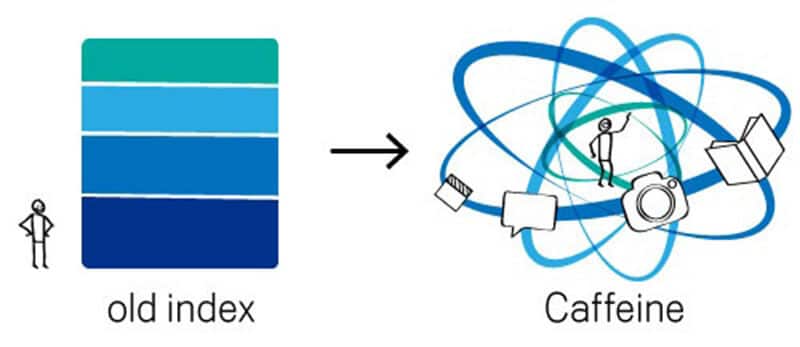Caffeine: Web Indexing On Overdrive
-

Aaron Gray
-
 April 26 , 2023
April 26 , 2023 -
 4 min read
4 min read
A month after May Day which impacted long-tail keywords, Google rolled out the Caffeine update which brought about a new web indexing system. It was announced back in August 2009 with a glimpse of a massive infrastructure change that prioritized real-time crawling, index expansion, and ranking integration. The final update was launched in June 2010 after several months of testing.
What’s It For
The Caffeine update was developed to keep up with the ever-evolving web and the rising expectations of users. Web content was rapidly becoming more complex with the integration of more media such as images and videos on top of the text content. Moreover, searchers want the most relevant content right after they typed in their query and site operators expect their pages to be found upon publishing their posts.
Google explained that the infrastructure change let go of the old index which had several layers. The primary issue with the previous model was that it refreshed some layers at a faster rate than others. This process implied that users don’t get access to all web pages that are relevant to their query; only the ones that were included in the update. The old index also led to a delay in the search engine’s discovery of a page and making it available to searchers.
With this update, Google analyzes the web bit by bit and refreshes its search index continuously and globally. As bots find freshly-published pages or new information on existing ones, the team adds the data straight to the index. Caffeine, which was built to be a robust foundation for future expansions of the search engine, can process thousands of pages in parallel every second.
What Were Its Effects
Caffeine led to a boost in the search engine’s raw speed as well as a 50 percent fresher index, as reported by Google. The update benefits both searchers and blog owners since it ensures that all content is discoverable within seconds after bots have crawled through newly-published pages.
These were the significant changes brought about by the update:
- More Accessible Content – As mentioned above, the primary advantage of Caffeine is that it allows users to access more content as it gets uploaded and crawled. It grants searchers with more relevant information especially with time-bound data like news and sport event scores.
- Storage Capacity Increase – According to Google, Caffeine takes up approximately 100 million gigabytes of storage in one database. Its considerable size enables it to add new data to the index at a rate of hundreds of thousands of gigabytes daily.
- Data Extraction Flexibility – The search engine processes a lot of information for each document including on-page elements like the content and media such as images and videos, meta tags, and other HTML codes. It also sifts through the blog post’s off-page aspects like the number of backlinks it has and other social signals. Caffeine provides more flexibility and easier annotation of the details that are stored for each page.
What It Means for You
Search has never been the same since Caffeine rolled out. It did serve as a robust foundation for future algorithm, ranking, and infrastructure changes. One particular update was Google Freshness which prioritized more recent content in SERPs. It’s all the more crucial for you to publish new posts regularly to maintain and improve your position in the results pages.
Here are a few tips on determining how often you should blog:
- Identify Your Content Marketing Goals – While posting regularly is highly-recommended, it may not be healthy to publish new content every day if you don’t have the resources for it. You should focus on creating top-notch content that will attract and engage your target audience. To do this, you should ask yourself what you want to achieve at this stage of your business; whether you want more readers or more engagement from existing subscribers.
- Count How Many Posts You’ve Published – Freshness doesn’t equate to creating new content daily. One useful tactic to do is to refresh your old posts with up-to-date information. You have to look at the posts you’ve published and evaluate which ones can be updated with supplemental data. Moreover, this practice can also show you which pages are popular and use those topics for future content.
- Test Out Different Posting Frequencies – The only way to find the ideal posting frequency for your website is to try out various schedules. Experimenting is the most efficient method to discover what works for you and your audience based on your digital marketing goals. The emphasis is on creating great content regularly that can engage with your current readers and attract new subscribers.


